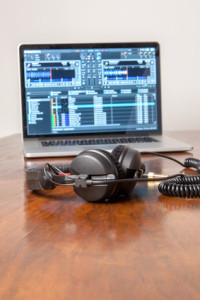- Calls to this hotline are currently being directed to Within Health, Fay or Eating Disorder Solutions
- Representatives are standing by 24/7 to help answer your questions
- All calls are confidential and HIPAA compliant
- There is no obligation or cost to call
- Eating Disorder Hope does not receive any commissions or fees dependent upon which provider you select
- Additional treatment providers are located on our directory or samhsa.gov
Music Therapy in the Treatment of Eating Disorders: Part Two
Contributor: Dean Quick, MT-BC, Program Director and Board Certified Music Therapist at TranscendED
 See Part 1 Here: Music Therapy in the Treatment of Eating Disorders
See Part 1 Here: Music Therapy in the Treatment of Eating Disorders
See Part 2 Here: Music Therapy in the Treatment of Eating Disorders Part 2
Note: None of the interventions outlined in this series should be applied to your own healthcare/treatment without the direct consultation of a board certified music therapist (MT-BC). If you are interested in seeking music therapy treatment, you can find an MT-BC in your area by visiting www.musictherapy.org.
In Part One of this series, I briefly outlined what music therapy is and differentiated it from music listening. The goal of that article is primarily to educate those who are unaware of what music therapy is and to deter from misconceptions about music therapy and the clinical practice of it.
Part Two of this series will outline some of the music therapy interventions I use with patients in treatment for eating disorders. As stated in the previous article, music therapy is only to be provided by board certified music therapists (MT-BC). In Part Three of this series, I will discuss techniques and ways music can be used independently in life and recovery.
Part Two
Music therapy is more than pressing play on a CD player and expecting change to effect itself because of the emotional content of music that’s perceived as “relaxing”. A common misconception about music therapy is that a certain genre or type of music is more helpful than all the rest. Music therapy is an individualized treatment process.
In fact, I use recorded music only about 15% of the time I am practicing music therapy. The other 85% of the interventions I use are facilitated with the use of live music therapy interventions. All interventions utilize preferred music of patients.
The Role of Recorded Music
 When I do use recorded music it’s typically at the request of a patient because the original recording holds components that can’t be recreated in the moment, i.e. full band, sound and emotion behind lead singer’s voice, etc.
When I do use recorded music it’s typically at the request of a patient because the original recording holds components that can’t be recreated in the moment, i.e. full band, sound and emotion behind lead singer’s voice, etc.
Even when I do use recorded music for a lyric analysis, I follow up the analysis portion of the lyrics with a songwriting intervention where patients rewrite the original lyrics to represent their current processes. I then play the song and sing their lyrics, thus creating a new experience. There’s a lot more to music therapy than the actual music.
This part of the series will outline specific music therapy treatment interventions and examples of their use with those in treatment for eating disorders. I will go over lyric analysis, clinical improvisation, and music-assisted relaxation.
Lyric Analysis
Lyric analysis in my work is most popular among the adolescent age group, where music seems to be most powerful in regards to forming and shaping identity. Once per week, adolescents at TranscendED participate in a lyric analysis group where they share music that is of most importance to them and the issues they are currently working through in treatment. Lyrics of each song are printed and shared among the group to drive discussion.
Recurring Themes in Lyric Analysis
Recurring themes in this adolescent group are:
- Body image
- Self-esteem
- Empowerment
- Depression
- Relationship issues
Typical lyric analysis groups are one hour in length. Approximately half of the discussion in these groups lead to the group rewriting the song that prompts the longer discussion, at the discretion of the patient who introduced the song.
Songwriting in Conjunction with Lyric Analysis
 Songwriting in conjunction with lyric analysis has not only been seemingly enjoyable for this group but also a way for the group to express their ideas and have positive control over media influences in their life. Lyric analysis does not allow for the extent of self-expression as clinical improvisation; however, lyric analysis can be less intimidating for the patient.
Songwriting in conjunction with lyric analysis has not only been seemingly enjoyable for this group but also a way for the group to express their ideas and have positive control over media influences in their life. Lyric analysis does not allow for the extent of self-expression as clinical improvisation; however, lyric analysis can be less intimidating for the patient.
Despite the differences, engagement in both of these clinical interventions validate clients’ feelings and allow them gain insight on their own processes as well as experience them in a new way.
Clinical Improvisation
A typical clinical improvisation intervention allows the client to freely improvise on whatever musical instrument chosen, as having choice in treatment can also have an impact on the person, as well as indicate his or her progress in rehabilitation. Instruments are typically chosen to meet or represent some underlying emotional need. (Bauer, 2010; Trondalen & Skårderud, 2007).
Improvisational Role Playing
Improvisational role playing is an example of clinical improvisation that I use. The following example includes the use of improvisational role playing with a group of 4 women, all with bulimia nervosa and Axis II diagnoses of borderline personality disorder. The group was given a worksheet prompting them to choose five parts of themselves individually to share with the group.
There were no limitations as to what parts of the self the individuals could choose. Examples given were “happiness”, “anxiety”, “compassion”, “bulimia”, etc. After writing these parts on small pieces of paper, the group was asked for a volunteer to share their roles first.
Reassigning Parts of the Self
 The participant who volunteered to share their roles first was asked to assign each of the “parts of their self” to group members and the MT-BC. This patient in the lead role was instructed to represent the emotion that they were feeling in the moment.
The participant who volunteered to share their roles first was asked to assign each of the “parts of their self” to group members and the MT-BC. This patient in the lead role was instructed to represent the emotion that they were feeling in the moment.
After each role was assigned, the patients leading then assigned an instrument to each role and instructed each individual how to embody their role musically. Once all group members were given their playing style, the patient leading the role playing was instructed to begin playing their instrument and to focus on her interactions with opposing or supporting roles.
The other group members were instructed to join in the improvisation in manners congruent with their embodied role, as instructed by the patient leading.
Verbal Processing
Once the improvisation ended the lead patient was engaged in verbal processing regarding her interactions with the roles musically and how it compares or differs with the roles how they occur organically in her life.
Since control is such a defining struggle for those diagnosed with eating disorders, it is a common theme introduced in role playing, as well as anxiety. This improvisational approach to role playing has allowed my adult groups to experience concurring roles within the Self in a nonverbal and nonthreatening way, opening discussion to the power of some roles over others in their lives, and to experience these roles in ways they are unable to in non-experiential therapies.
Music – Assisted Relaxation
The use of music-assisted relaxation with this population, as with any other mental/behavioral health population, should be introduced slowly and carefully. Since a large number of individuals with eating disorders have a history of trauma, music-assisted relaxation can be terrifying for some.
Clients with Trauma-Heavy Backgrounds
 Because of the intimate nature of the intervention, clients with trauma-heavy backgrounds may avoid and/or request not to participate in music-assisted relaxation involving imagery. Contrarily, this intervention can be a way for patients to work through the trauma by re-experiencing the emotions related to the instance(s) in the presence of and supported by the music therapist.
Because of the intimate nature of the intervention, clients with trauma-heavy backgrounds may avoid and/or request not to participate in music-assisted relaxation involving imagery. Contrarily, this intervention can be a way for patients to work through the trauma by re-experiencing the emotions related to the instance(s) in the presence of and supported by the music therapist.
Imagery-based Experiences
Imagery-based experiences, as lead by the music chosen by the MT-BC, can unlock inner pathways that may allow patients to experience emotions in different and profound ways.
Music-assisted progressive muscle relaxation can be used for increasing appropriate body awareness and has been effective for adolescent groups in my work for not only improving their self-reported comfort level with their body image but also as means to opening discussion on the issue of body image.
How Can I Use Music for My Own Recovery?
The next and final part of this series will discuss the importance of acknowledging and exploring the music in your life, whether you are in recovery or are just interested in learning more about yourself through music.
Community Discussion – Share your thoughts here!
What has been your experience with Music Therapy? How has this type of therapy impacted your recovery?
About the Author:
Dean Quick, MT-BC is the Program Director and Board Certified Music Therapist for TranscendED where we understand the value of recovery, and believe that all individuals should have equal access to treatment. At TranscendED it is our goal to provide quality treatment, vigorous advocacy, multi-disciplinary education, and abundant support to those directly and indirectly affected by eating disorders. TranscendED is one of very few eating disorder treatment centers to accept Medicaid.
References:
- Bauer, S. (2010). Music therapy and eating disorders: A single case study about the sound of human
needs. Voices: A World Forum for Music Therapy, 10(2). - Trondalen, G. & Skårderud, F. (2007). Playing with affects… and the importance of “affect attunement.”
Nordic Journal of Music Therapy, 16, 100-111.
Last Updated & Reviewed By: Jacquelyn Ekern, MS, LPC on June 19th, 2015
Published on EatingDisorderHope.com

